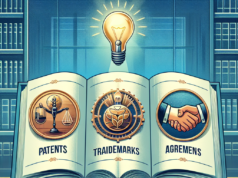
In an increasingly interconnected and digital world, the significance of intellectual property (IP) has never been more pronounced. As innovation accelerates and creative endeavors proliferate, the legal battles surrounding IP rights have become a focal point for businesses, artists, and inventors alike. This article delves into the hidden battles of intellectual property lawsuits, exploring their implications, the players involved, and the evolving landscape of IP law.
Understanding Intellectual Property: A Comprehensive Overview of Its Importance and Scope
Intellectual property encompasses a range of legal rights that protect creations of the mind, including inventions, literary and artistic works, designs, symbols, names, and images used in commerce. The primary types of IP include patents, copyrights, trademarks, and trade secrets. These protections are crucial for fostering innovation and creativity, as they provide creators with exclusive rights to their work, thereby incentivizing investment in new ideas and technologies. The scope of IP extends beyond individual creators; it plays a vital role in economic growth, encouraging competition and ensuring that businesses can protect their unique offerings in the marketplace.
The Rise of Intellectual Property Lawsuits: Trends and Statistics in Recent Years
In recent years, the landscape of intellectual property lawsuits has witnessed a significant surge. According to data from the U.S. Patent and Trademark Office, the number of patent litigation cases has increased by over 20% in the past decade, with a notable rise in cases involving technology and pharmaceuticals. This trend reflects the growing importance of IP in the digital age, where innovations are rapidly developed and disseminated. Additionally, the rise of social media and online platforms has led to an increase in copyright infringement cases, as content creators seek to protect their work from unauthorized use. The financial stakes in these lawsuits are substantial, with settlements and damages often reaching millions of dollars, underscoring the high stakes involved in IP disputes.
Key Players in Intellectual Property Disputes: Who’s Involved and What Are Their Roles?
Intellectual property disputes typically involve a diverse array of stakeholders, each playing a critical role in the litigation process. At the forefront are the plaintiffs—individuals or companies claiming that their IP rights have been infringed. Defendants, on the other hand, are those accused of violating these rights. Legal representatives, including specialized IP attorneys, are essential in navigating the complexities of these cases, providing expertise in both litigation and negotiation. Additionally, industry associations and advocacy groups often become involved, either supporting plaintiffs or defendants, depending on the broader implications of the case for their respective sectors. Finally, the judiciary plays a pivotal role, as judges and juries are tasked with interpreting IP laws and determining the outcomes of disputes.
The Legal Framework: Navigating the Complexities of Intellectual Property Law
The legal framework governing intellectual property is intricate and varies significantly across jurisdictions. In the United States, IP law is primarily governed by federal statutes, including the Patent Act, the Copyright Act, and the Lanham Act for trademarks. Each type of IP has its own set of rules, requirements, and enforcement mechanisms, making it essential for stakeholders to understand the nuances of the law. Internationally, treaties such as the Agreement on Trade-Related Aspects of Intellectual Property Rights (TRIPS) aim to harmonize IP protections across borders, yet disparities remain. As globalization continues to shape the economy, navigating these complexities becomes increasingly challenging, necessitating a robust understanding of both domestic and international IP laws.
Case Studies: Notable Intellectual Property Lawsuits That Shook Industries
Several high-profile intellectual property lawsuits have left an indelible mark on various industries, illustrating the profound impact of IP disputes. One notable case is the ongoing battle between Apple and Samsung over smartphone patents, which has spanned multiple countries and resulted in billions of dollars in damages. This case not only highlighted the fierce competition in the tech industry but also raised questions about the boundaries of patent protection. Another significant case involved the music industry, where the Recording Industry Association of America (RIAA) pursued legal action against file-sharing platforms, ultimately leading to landmark rulings that shaped copyright enforcement in the digital age. These cases exemplify how IP lawsuits can influence market dynamics, drive innovation, and redefine industry standards.
The Future of Intellectual Property: Emerging Challenges and Potential Reforms
As technology continues to evolve, the future of intellectual property faces a myriad of challenges that could reshape the legal landscape. The rise of artificial intelligence and machine learning presents unique questions regarding authorship and ownership of generated content. Additionally, the proliferation of digital platforms complicates copyright enforcement, as traditional models struggle to keep pace with the speed of information sharing. Furthermore, the ongoing debate over patent reform seeks to address issues such as patent trolls—entities that exploit the legal system to extract settlements without producing any products or services. As stakeholders grapple with these emerging challenges, potential reforms may be necessary to ensure that intellectual property laws remain relevant and effective in promoting innovation while balancing the interests of creators and consumers.
The hidden battles of intellectual property lawsuits reveal a complex interplay of creativity, innovation, and legal intricacies. As the landscape continues to evolve, understanding the importance of IP, the trends in litigation, and the roles of various stakeholders becomes essential for navigating this critical area of law. With emerging challenges on the horizon, the future of intellectual property will undoubtedly require ongoing dialogue and potential reforms to adapt to the ever-changing dynamics of a globalized economy.



























